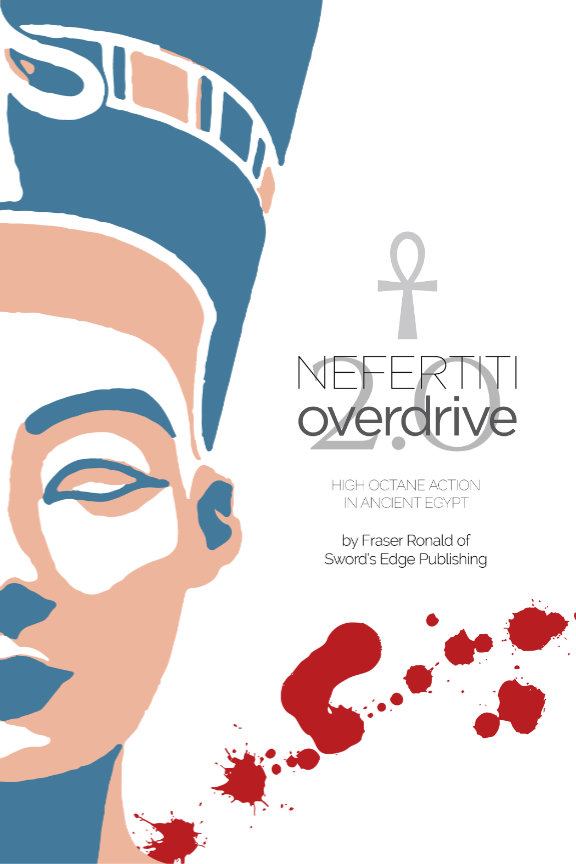Every week I’m trying to get two articles up on the website, but some weeks it’s tougher than others. Tuesdays I generally like to have an advice column while on Thursdays I write about inspiration. This time, instead of providing advice, I’m going to let you know what is happening over at SEP.
 The main concern for SEP (which is me) right now is Nefertiti Overdrive. It is in layout and the graphic designer – Rob Wakefield, who has laid out all our books since at least the Khorforjan Gambit – is optimistic about getting it back to me early July. Fingers are crossed. Once we get those files in a format with which we are both happy, the PDFs will be sent off to backers and to the printers to get some books done. I wish printing were faster, but due to schedules and the early start to Gen Con this year, I can’t see us having any Nefertiti Overdrive books to sell at the con.
The main concern for SEP (which is me) right now is Nefertiti Overdrive. It is in layout and the graphic designer – Rob Wakefield, who has laid out all our books since at least the Khorforjan Gambit – is optimistic about getting it back to me early July. Fingers are crossed. Once we get those files in a format with which we are both happy, the PDFs will be sent off to backers and to the printers to get some books done. I wish printing were faster, but due to schedules and the early start to Gen Con this year, I can’t see us having any Nefertiti Overdrive books to sell at the con.
However, I will be at the convention. The Nefertiti Overdrive games that I am running are all full, but I’ll be on the panel for a couple of seminars, and there are seats available to those. On Friday at 9 AM, I have “Indie RPG Matchmaker” with Jason Pitre of Genesis of Legend Publishing, while on Saturday at 1 PM, Ben Woerner who wrote World of Dew and I sit down to talk about “Historical Gaming.” I will be selling copies of both Sword Noir and Centurion there at the Independent Game Designers Network booth. Come by, say hi, shake hands and chat!
The play test for the game with the working title A Team of Pulp Losers is winding down, and the rules have proved successful through a one-year campaign. I am wondering about beta-testing these rules, but have had difficulty finding playtesters beyond my alpha-test circle. In the end, there is no business plan for these rules. I have not costed-out a release because I am a bit burned out on Kickstarter. What will happen to these rules? First, I need to find a better name. After that? We shall see.
Another system is ready to go for Gen Con. I’m calling it Fancy Pants because – as noted above – I suck at creating good titles. Fancy Pants is a game very much in the vein of Nefertiti Overdrive. It provides players with the opportunity to control the narrative and pushes them to get fancy – describing “success or failure in a way that is dramatic, cinematic, amusing or otherwise dazzling.” Unlike Nefertiti Overdrive, rather than providing an incentive by providing better dice or bonuses, getting fancy is tied to advancement. One Fancy Pants session at Gen Con will be based on Borderlands 2 while another is going to be a high octane action take on Sword Noir.
I honestly have no idea what will happen with Fancy Pants . . . even if it finds itself a good name.
There are two other completed systems that are steps between Nefertiti Overdrive and A Team of Pulp Losers: Direct Action and Starship Commandos. I’ve written about both games before, and they have both had shakedowns. They lack art or professional layouts, but they are ready to move forward.
And even with a backlog of four games, I have a new one for which I am about to pull the trigger on playtesting. This one is termed Riggers, although that name no longer applies. Riggers was tied more to the setting than the system, and I am working on playtesting the rules in a campaign attractive to my players. I intend to use the scenario generation system from Nefertiti Overdrive to create the campaign for the Riggers playtest. Maybe the setting will work with the name.
Riggers won’t be ready for prime time for at least a year. Like Centurion, it is a system built from scratch. Nefertiti Overdrive, like Sword Noir, was inspired by mechanics encountered elsewhere. Riggers was built from the ground up. I’m not going to say it’s totally new and unique, because I honestly expect someone at some point to say “this works just like X.” Still, because it’s new and unique to me, it’ll take a while to work out the kinks. Centurion changed dramatically during the playtest, and I expect something similar from Riggers.
So, there you go. Three completed games, two getting ready to have their tires kicked. Once Nefertiti Overdrive is in the hands of the backers, I’ll be doing some serious thinking about what I want to do and how I want to do it.
Until then, stick around. Let’s chat over at the SEP G+ group.




 A discussion elsewhere has led me to consider choices made in designing Centurion – one of my games that was not inspired by other systems but was wholly independently designed. Centurion: Legionaries of Rome, as its title implies, is a game about Roman legionaries, and more specifically the kinds of special troops that might find themselves in a testudo facing raging barbarians, but which are more likely to be in advance of the legions, scouting out the activities of those barbarians or even infiltrating the camps or cities of rival civilizations. The development of Centurion seems so long ago (I guess 2012 was a few years back), but I had some very clear design goals.
A discussion elsewhere has led me to consider choices made in designing Centurion – one of my games that was not inspired by other systems but was wholly independently designed. Centurion: Legionaries of Rome, as its title implies, is a game about Roman legionaries, and more specifically the kinds of special troops that might find themselves in a testudo facing raging barbarians, but which are more likely to be in advance of the legions, scouting out the activities of those barbarians or even infiltrating the camps or cities of rival civilizations. The development of Centurion seems so long ago (I guess 2012 was a few years back), but I had some very clear design goals.
 Back in the day, before I updated the system, I ran a very short game set in an alternate Rome centred on Alba Longa this was before the creation of Centurion: Legionaries of Rome. The characters were are exploratores legionary scouts and spies with Legio VI Ferrata (Ironclad), under the Legate (general) Titus Fabius Valens based in a fortress along the Dacian Ister Wall, on the banks of the massive Ister river. The story involved a rising in the barbarian lands to the North and the PCs finding out about this and embedding with the barbarians to protect the Alban Empire from this threat.
Back in the day, before I updated the system, I ran a very short game set in an alternate Rome centred on Alba Longa this was before the creation of Centurion: Legionaries of Rome. The characters were are exploratores legionary scouts and spies with Legio VI Ferrata (Ironclad), under the Legate (general) Titus Fabius Valens based in a fortress along the Dacian Ister Wall, on the banks of the massive Ister river. The story involved a rising in the barbarian lands to the North and the PCs finding out about this and embedding with the barbarians to protect the Alban Empire from this threat.


 Tell me that’s not awesome. Actually, don’t do that, because then I would be legally required to smack you in the mouth . . virtually, as in over the intarwebs, and since I don’t know how to do that, don’t make me.
Tell me that’s not awesome. Actually, don’t do that, because then I would be legally required to smack you in the mouth . . virtually, as in over the intarwebs, and since I don’t know how to do that, don’t make me. Kieron did fantastic work for Centurion, and this is my favourite from that.
Kieron did fantastic work for Centurion, and this is my favourite from that. Yeah, I guess otherwise, if I had to choose something from outside my own games I’d have to go with the first cover to the AD&D PHB. Not so much because it is something I think is particularly evocative on its own, but because it has become so iconic.
Yeah, I guess otherwise, if I had to choose something from outside my own games I’d have to go with the first cover to the AD&D PHB. Not so much because it is something I think is particularly evocative on its own, but because it has become so iconic.
 Pivots are pretty important when I design adventures. The players are telling me this is what they want their characters to do, so I better make sure their characters get to do that. However, there is a large difference between using Pivots in a regular, ongoing campaign and in a one-shot or convention game.
Pivots are pretty important when I design adventures. The players are telling me this is what they want their characters to do, so I better make sure their characters get to do that. However, there is a large difference between using Pivots in a regular, ongoing campaign and in a one-shot or convention game. The main concern for SEP (which is me) right now is Nefertiti Overdrive. It is in layout and the graphic designer – Rob Wakefield, who has laid out all our books since at least the Khorforjan Gambit – is optimistic about getting it back to me early July. Fingers are crossed. Once we get those files in a format with which we are both happy, the PDFs will be sent off to backers and to the printers to get some books done. I wish printing were faster, but due to schedules and the early start to Gen Con this year, I can’t see us having any Nefertiti Overdrive books to sell at the con.
The main concern for SEP (which is me) right now is Nefertiti Overdrive. It is in layout and the graphic designer – Rob Wakefield, who has laid out all our books since at least the Khorforjan Gambit – is optimistic about getting it back to me early July. Fingers are crossed. Once we get those files in a format with which we are both happy, the PDFs will be sent off to backers and to the printers to get some books done. I wish printing were faster, but due to schedules and the early start to Gen Con this year, I can’t see us having any Nefertiti Overdrive books to sell at the con.